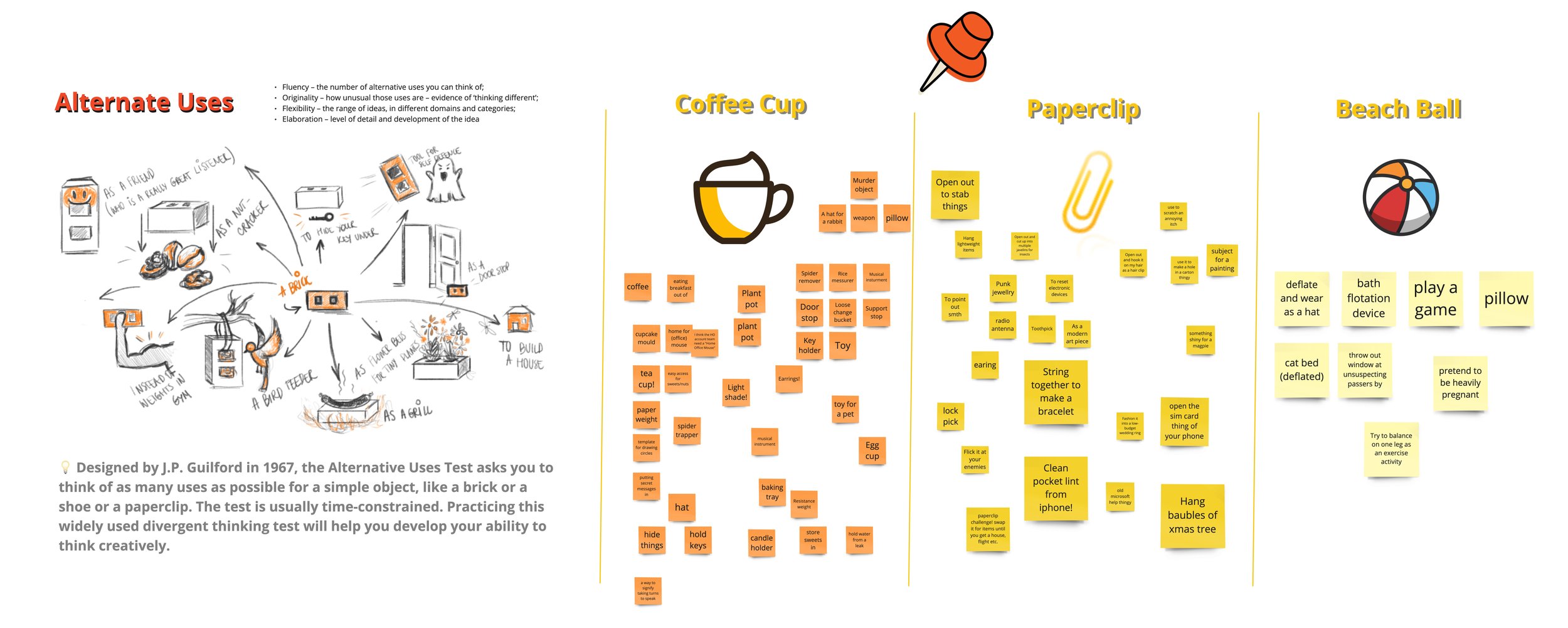Unleashing Creative Potential: Exploring Alternate Uses with Design Thinking
In a world that constantly demands innovation and fresh perspectives, design thinking has emerged as a powerful approach to problem-solving. Last week, I had the privilege of facilitating a remote session that revolved around the intriguing concept of alternate uses using design thinking. Through this activity, we explored the extraordinary possibilities hidden within ordinary objects like a coffee cup, paperclip, and beach ball. Join me as we delve into the transformative power of design thinking and the significance of the alternate uses activity.
Example of the exercise being facilitated in Miro
Unleashing the Creative Genius:
Design thinking, at its core, empowers individuals to tackle complex challenges by embracing empathy, creativity, and practicality. It encourages us to step out of our comfort zones, think beyond traditional boundaries, and explore new territories. The alternate uses activity acts as a catalyst, stimulating our imagination and unlocking our creative potential.
A Historical Connection:
The origins of the alternate uses activity can be traced back to the groundbreaking work of J.P. Guilford, a renowned psychologist. In 1967, Guilford introduced the concept of "divergent thinking," emphasizing the importance of generating a multitude of ideas to foster creativity. The alternate uses exercise aligns perfectly with this principle, enabling us to break free from linear thinking and explore a wide range of unconventional applications.
The Power of Imagination:
During our remote session, the participants embarked on a journey of boundless creativity. We challenged ourselves to reimagine a coffee cup, paperclip, and beach ball, seeking alternate uses beyond their intended purposes. What we discovered was truly inspiring. The coffee cup transformed into a unique plant pot, the paperclip became a versatile bookmark or even an emergency lock pick, and the beach ball evolved into a floating fruit basket or a stress-relieving tool. The possibilities were as vast as our imagination allowed.
Beyond the Activity:
Engaging in the alternate uses activity not only stimulates our creative spark but also develops vital skills for problem-solving and innovation. It encourages us to challenge assumptions, think critically, and approach challenges from diverse perspectives. Moreover, this activity fosters collaboration and teamwork, as participants bring forth a myriad of unique ideas, sparking collective creativity.
The Relevance in Today's World:
In a rapidly evolving landscape, embracing design thinking and activities like alternate uses is more important than ever. Organizations seek individuals who can think outside the box, envision new possibilities, and drive innovation. Design thinking empowers us to adapt and thrive in an ever-changing world, where creative problem-solving is highly valued.
Conclusion:
The alternate uses activity within design thinking holds immense potential to unleash our creative genius. By stepping outside the confines of traditional thinking, we can discover innovative solutions and approaches. Let's continue to embrace design thinking, inspire one another, and reshape the world with our boundless creativity. Together, we can unlock a future brimming with innovation and endless possibilities.
So, let's embark on this transformative journey of design thinking, explore alternate uses, and harness our creative potential to shape a brighter tomorrow.

